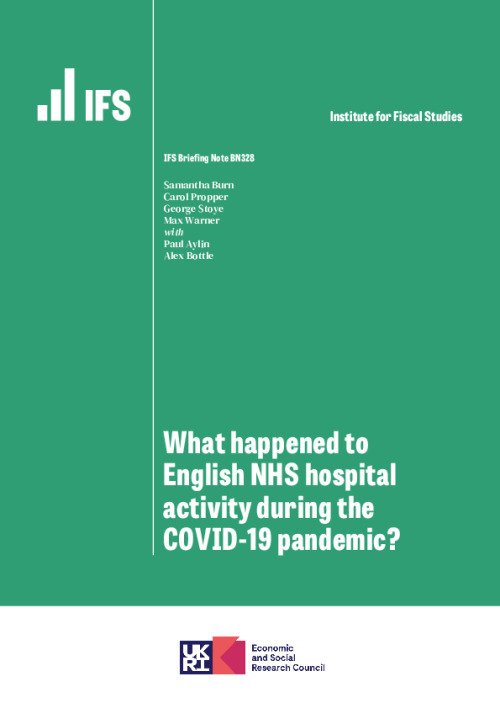The COVID-19 pandemic has had profound effects on healthcare systems around the world, including the UK National Health Service (NHS). As a result of a reorganisation of services and changes in the care needs and care-seeking behaviour of patients, the use of hospitals in England has changed drastically. However, exactly how much and what type of care has taken place, and the extent to which these patterns vary across different groups of individuals, has not yet been comprehensively documented. Better evidence on this is required to address backlogs in care, and to understand to which groups resources should be particularly targeted after the acute phase of the pandemic is over.
In this briefing note, we use administrative hospital data from across the NHS in England to describe how the use of inpatient (elective and emergency) and outpatient hospital care in 2020 compared with that in the previous year. We first show how overall levels of care changed in the period after the start of the pandemic in March until the end of December 2020 and then examine how changes in activity varied across regions and clinical specialties. We finally examine how these patterns differ across patient age, ethnicity and local area deprivation.
Our findings suggest a complex response to the pandemic driven by large drops in supply for non-COVID services and demand-side responses to the pandemic. They also underline the need to increase available resources to address care backlogs and to direct resources to the people, local areas and groups that have been most affected.
Key findings
- Between March and December 2020, there were 2.9 million (34.4%) fewer elective (planned) inpatient admissions, 1.2 million (21.4%) fewer non-COVID emergency inpatient admissions, and 17.1 million (21.8%) fewer outpatient appointments compared with the same period in 2019.
- There was a sharp reduction in hospital activity in March 2020. Although emergency inpatient admissions had almost returned to their 2019 level by August, elective and outpatient volumes remained substantially below their 2019 levels for the rest of 2020. Emergency inpatient admissions began to decline again (relative to 2019) in September.
- All regions of England saw large reductions in hospital activity relative to the same period in 2019, with some variation between different regions and by type of admission. At the extremes, Yorkshire and the Humber had 39.5% fewer elective admissions between March and December 2020, compared with a reduction of 30.3% in the South West. London had 24.4% fewer emergency admissions, compared with a fall of 15.6% in the South West. Across all care types, the North and the Midlands had larger reductions in hospital activity than the South and the East of England.
- Reductions in volumes of care varied across clinical specialties. There were 57.4% (332,000) fewer trauma and orthopaedic elective admissions, compared with only 6.6% (46,000) fewer for nephrology. Paediatrics saw by far the largest reduction in emergency admissions, a reduction of 41.0% (242,000) compared with the same period the year before.
- Individuals from the most deprived local areas had 23.3% fewer emergency admissions in March to December, compared with a 20.2% reduction for those in the least deprived areas. In absolute terms, the gap in activity between areas is substantially larger, since more deprived areas have more emergency admissions. There is little difference in the percentage falls for elective admissions and outpatient appointments between more and less deprived areas.
- Since older people are the largest users of hospital care, older people were, unsurprisingly, the most affected in per-capita terms. The drops were, however, very large: for those aged 80+, there were 122.5 fewer elective admissions per 1,000 population, 82.4 fewer emergency admissions and 835.7 fewer outpatient appointments between March and December. But when looking in relative terms, children (under-18s) had the largest percentage declines in both elective (37.0%) and emergency (38.5%) inpatient admissions.
- There are substantial differences by ethnicity. The largest percentage decreases in elective inpatient admissions were among white and Asian individuals, while the largest percentage decreases in emergency inpatient admissions were among Asian, black and mixed ethnicity individuals.
A breakdown of the regional data found here was given to The Sunday Times upon request.














